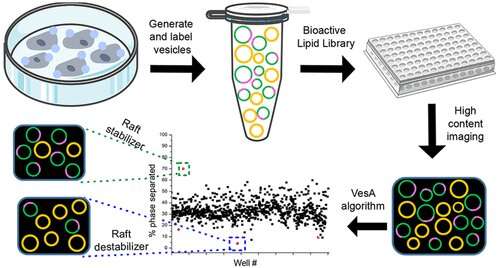
Lipid rafts, a component of the
plasma membranes that surround all cells in the human body, are essential in
regulating the membranes' structure, among other functions. But they are hard
to study because traditional biochemical methods tend to destroy them.
Chuck Sanders, associate dean for research, professor of biochemistry and medicine and Aileen M. Lange & Annie Mary Lyle Chair for Cardiovascular Research, and his lab collaborated with corresponding author Anne Kenworthy at the University of Virginia School of Medicine to develop new techniques for discovering the small molecules that regulate lipid rafts. Their article was published in ACS Central Science in February 2022.
"Raft-modulatory small molecules are likely an important part of fundamental biological processes," Sanders said. "Lipid rafts are like a clique at a party—always together. This work describes a way of discovering the small molecules that either 'dissolve' these molecular cliques or that enhance their formation."
Lipid rafts are composed of lipids and proteins that stick together as they move within the plasma membrane, like small rafts in the ocean. They assist in cellular transport, signal transduction and immune system functions. For example, the enzymes responsible for production of the amyloid-beta polypeptide closely associated with Alzheimer's disease are thought to reside in lipid rafts.
So learning more about the molecules that regulate lipid raft function may turn out to be disease therapeutic. In addition to Alzheimer's, alterations in lipid rafts have been associated with cancer cells that are resistant to chemotherapy. These molecules will also be important research tools that will better enable investigators to study the roles of rafts in healthy and diseased biological processes.
"In the short term, the robust methods described in this work should lead to the discovery of small molecule tools that can be used either to enhance or to suppress lipid raft formation in research," Sanders said. "In the long term, we hope some of the molecules discovered will have utility in research, biotechnology and medicine."
The screening technique is up for a patent that will be shared by Vanderbilt and the University of Virginia. The Sanders lab will expand and refine the screening approach described in this paper.
"We are seeking to further this approach to discover small molecules that specifically assist with driving membrane proteins in and out of the lipid rafts," Sanders said.

 Previous page
Previous page Back to top
Back to top







